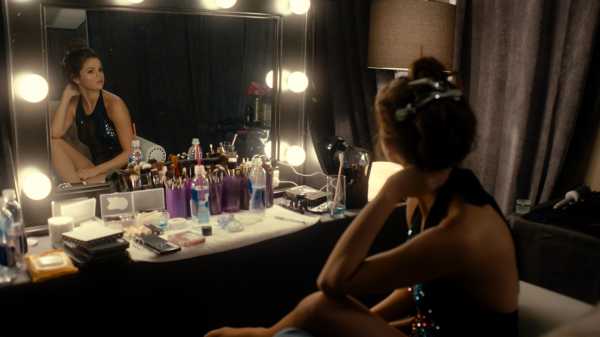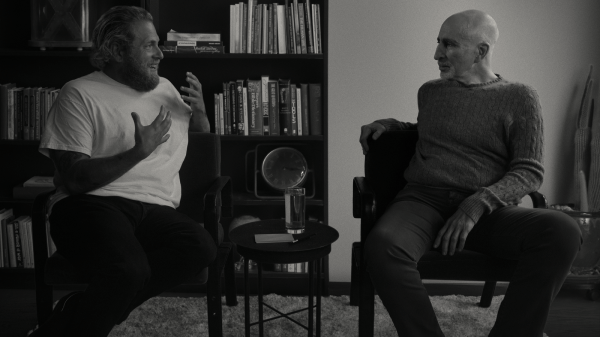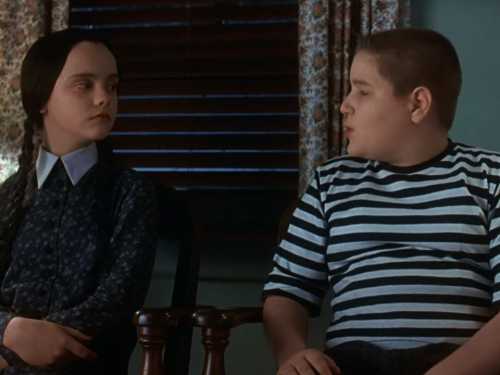
In the old days—circa 2012, maybe—we would call it exhaustion. Exhaustion was the nebulous catchall term used to describe the distress incurred by celebrities who had been on tour for too long, who had been hounded too aggressively by paparazzi, who had jumped from project to project with no rest, or who had indulged too much. Exhaustion was the celebrity’s cross to bear: it threatened to derail the art, to thwart the tour, to delay the filming of the next movie. Today’s celebrities, though, do not suffer from exhaustion so much as grapple, painstakingly and publicly, with their own mental health. And these periods of grappling no longer threaten to derail the art—the process of caring for one’s mental health is the art.
Recently, the actor-director Jonah Hill and the actor–pop star Selena Gomez embraced their mentally fraught journeys by making documentaries about them. “Stutz” (Hill’s film) and “My Mind & Me” (Gomez’s) are two modern, ultra-meta iterations on the celebrity documentary, primed for a streaming audience and tailored to a moment in which public vulnerability is celebrated. Neither has a traditional redemption arc; instead, they speak to the hazy, nonlinear nature of psychological turmoil and well-being.
Hill’s documentary feature, “Stutz,” which was released in November on Netflix, is framed as a portrait of his longtime therapist, Dr. Phil Stutz. Like Showtime’s “Couples Therapy,” which elegantly chronicles the work of a relationship therapist in New York City, Hill’s film cultivates an immediate—and almost illicit-feeling—intimacy by inviting the camera into the sacred space of the therapist’s office. Early on, we see Hill, sitting in a chair across from Stutz as they discuss the therapist’s methodology. “I’ve decided to make this because I want to present your tools . . . in a way that allows people to access them and use them to make their own life better,” Hill says. “And do it in a way that also honors the life of somebody that I deeply care about and respect.” Hill’s decision to train the camera on Stutz’s life and ideas, instead of on himself, is at once an act of deflection and curiosity.
To honor Stutz’s life, Hill offers up a brief biography of the therapist, a Bronx-born seventy-five-year-old who grew up with a convivial father and an emotionally paralyzed mother. Stutz’s little brother died at the age of three, and Stutz was diagnosed with Parkinson’s in his late fifties. As a therapist, he developed an unorthodox approach to treating his patients. “The average shrink will say, ‘Don’t intrude on the patient’s process. They will come up with the answers when they’re ready,’ ” he tells Hill, his patient turned director. “That sucks. That’s not acceptable.” “Stutz” is framed as a document of candor, but Hill strategically avoids the potentially distracting reality that Stutz is already something of a public figure. Throughout his career, Stutz has earned a reputation as a go-to Hollywood therapist who’s helped everyone from Gwyneth Paltrow to Adam McKay unblock their creative channels.

The decision of Jonah Hill (left) to train the camera on Stutz’s life and ideas, instead of on himself, is at once an act of deflection and curiosity.Photograph courtesy Netflix
It is not difficult to understand why these people turn to Stutz, who rejects the approach of conventional therapy. Rather than remain neutral, he has concrete tools that provide some relief in the first session. His tools and ideas have catchy, marketable names that allow for easy recall: String of Pearls refers to the process of taking small actions, which accumulate to make something meaningful; the Shadow is the part of every human being that they’re ashamed of; the Snapshot refers to the realm of illusion that most of us are trapped in, imagining a future in which a perfect experience exists. The “inner work” of a therapy patient is not an especially exciting or easy thing to render onscreen, but Hill finds a work-around by visually narrating Stutz’s tools with the therapist’s own messy, shaky, hand-drawn illustrations, which also serve as reminders of the debilitating effects of Parkinson’s.
Gomez, too, deploys the symbolic intimacy of handwriting in “My Mind & Me,” which was released in November by Apple TV+. In between vérité-style scenes of the pop star agonizing over the demands of live performance, or visiting her tiny home town in Texas, or drafting a public announcement of her bipolar diagnosis, Gomez is pictured (also in black-and-white) in a bathtub with floating rose petals, emerging from the water, or covered with glitter and mascara as handwritten diaristic quotes flash across the screen. “Just be who you are Selena. Just stop trying,” one scrawl reads. “No one cares about what you’re doing. It’s about who I am.” Directed by the prestige documentarian Alek Keshishian—who reimagined what celebrity documentaries could be in 1991, with the backstage drama of “Madonna: Truth or Dare”—this film captures Gomez in seemingly private moments.
Even in the context of the punishing demands of the modern celebrity-industrial complex, Gomez has had a rough go of it. At a young age, she was transplanted from a lower-middle-class life in Texas to the Disney child-star machine. Her early days of pop stardom were defined by her relationship with Justin Bieber, and the ghost of their puppy love seems to follow her today. (It also surely contributed to her status as one of the most followed musicians on social media.) Sometime in her early twenties, Gomez was diagnosed with the autoimmune disorder lupus, which necessitated a kidney transplant in 2017. In 2018, in the aftermath of the operation, she suffered a bout of psychosis and wound up institutionalized—her mother learned about it from TMZ. This period of physical and emotional turbulence is the subject of “My Mind & Me,” and Keshishian does a superb job depicting its unpleasant fallout.
Like “Stutz,” “My Mind & Me” is premised on the idea that vulnerability is the highest of virtues. Culturally speaking, there is good reason to believe that this is true. In recent years, Naomi Osaka has become a sports icon less for her on-court performance and more for her willingness to cop to mental-heath struggles. In August, Megan Thee Stallion released an album called “Traumazine,” which was accompanied by an interactive Web site that prompted fans to answer the question “How do you cope?” When braided into the act of self-promotion—something that is often insincere by design—the very idea of vulnerability gets murky. Still, there are some compelling flashes of vulnerability in “My Mind & Me,” which pictures Gomez not just in moments of sympathetic despair but also in fits of bratty and unsavory outrage. There’s a cabal of maternal handlers and friends around her at all times, and they are first in the firing line when she unravels. “You think I’m ungrateful,” Gomez accuses her longtime friend Raquelle in one scene. “I don’t think you’re ungrateful. I just feel like you’ve been so . . . down the past couple of days, so I’m trying to figure out what’s going on,” the friend replies, gently. Gomez, visibly irate, pushes back. “What else do you want from me?” she asks. Later, Gomez is infuriated by the insipid questions asked during a press run for her 2020 record, “Rare.” She plays frivolous games and gets asked questions such as whether she eats Oreos with a fork. “It just seems like such a waste of time” Gomez says, exasperated.
Fame, of course, is partly to blame for Gomez’s problems—but Keshishian resists using notoriety as a scapegoat, instead exploring the underlying physical and psychological problems that his subject has endured. It has become all too easy for the famous to create a kind of hall of mirrors with their public personas, using their enormous platforms to lament the challenges of having such enormous platforms. In the most recent season of “The Kardashians,” the producers return again and again to plotlines about how stressful fame can be. There is even an episode about the anxiety wrought by the première party for the previous season—as if the spotlight is a fate delivered entirely by some outside force, rather than repeatedly sought out. Prince Harry and Meghan Markle, similarly, have turned to the documentary format to further build their new post-Royal brand. “Harry & Meghan,” a six-part series that’s part of a Netflix deal reportedly worth between a hundred and a hundred and fifty million dollars, is ostensibly an act of vulnerability and a chance to invite viewers into the rarefied universe of Royal life, but the film does more to critique the press and lament the undesired effects of being in a global spotlight. But the series—which broke Netflix’s streaming records for a documentary début—could only serve to amplify the attention.
Hill, similarly, grapples with the impact of the spotlight in “Stutz.” At one point, the story shifts away from Stutz and back toward his patient. About a third of the way into the film, Hill realizes he’s blocked and is having trouble completing the project. Instead of giving up, he uses his despair as a teachable therapeutic moment by confessing to Stutz that he’s struggling. He admits to the audience that he and Stutz have been shooting in front of a green screen rather than Stutz’s office, and that he’s wearing a hairpiece for visual continuity. “I’ve been lying to you in our private therapy sessions about how the movie’s going,” he tells Stutz. “I’ve been essentially paying you to lie to you. . . . I’m trying to land these massive ideas and also tell the story of your life, but I just feel stuck. . . . Was this a fucking terrible idea for a patient to make a movie about his therapist?” Exposing his insecurity—a textbook act of vulnerability—happens to be a clever way of engineering new material for “Stutz.” The film, then, starts exploring Hill’s own psyche and his therapeutic journey, and the anguish he suffered as he transformed from a chubby teen-ager to a svelte Academy Award-nominated actor and director. Through his work with Stutz, he wrestles with the impact that the media have had on his self-image, and he finds shared ground with the therapist over the untimely death of his older brother, in 2017. At one point, Hill’s mother even joins a session to discuss their respective struggles with weight and body image.
As Hill finished “Stutz” and geared up to release the film, he found himself in a bind. He’d made a documentary about therapy, but he knew that promoting the film would be detrimental to his emotional well-being. To solve the conundrum, he made a choice that could, depending on which therapeutic ideals you subscribe to, be seen as either brave or craven: he used the press to inform his audience that he would not be doing press. “You won’t see me out there promoting this film, or any of my upcoming films, while I take this important step to protect myself,” he wrote, in an open letter published by Deadline. “If I made myself sicker by going out there and promoting it, I wouldn’t be acting true to myself or to the film.” Watching “Stutz” only makes you wonder what the therapy sessions around this decision were like, and how Dr. Stutz feels about such a declaration. ♦
Sourse: newyorker.com






